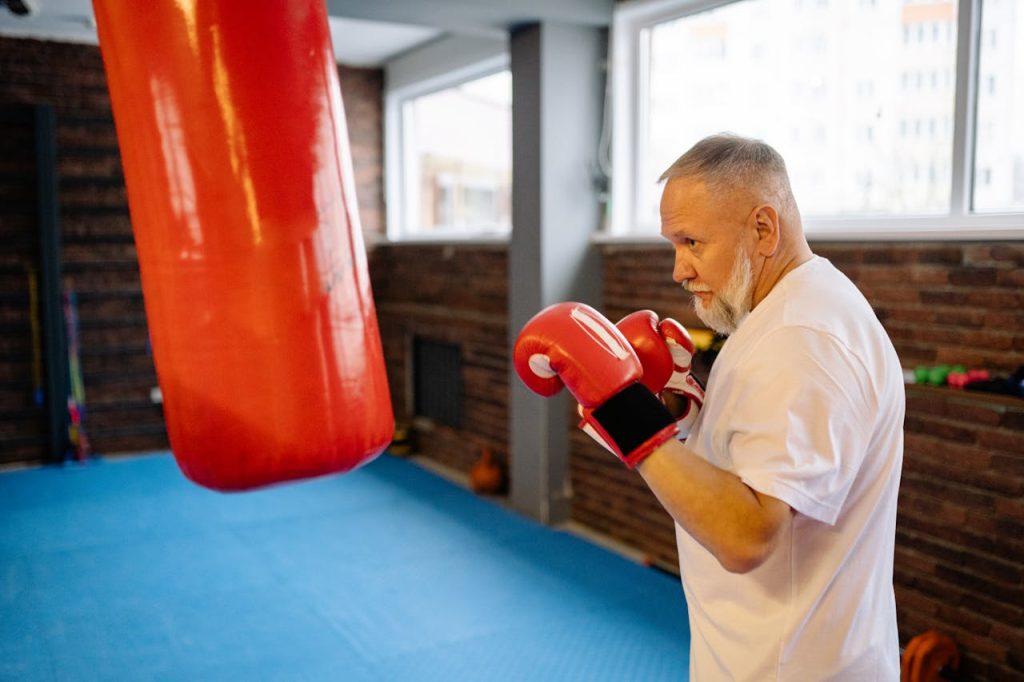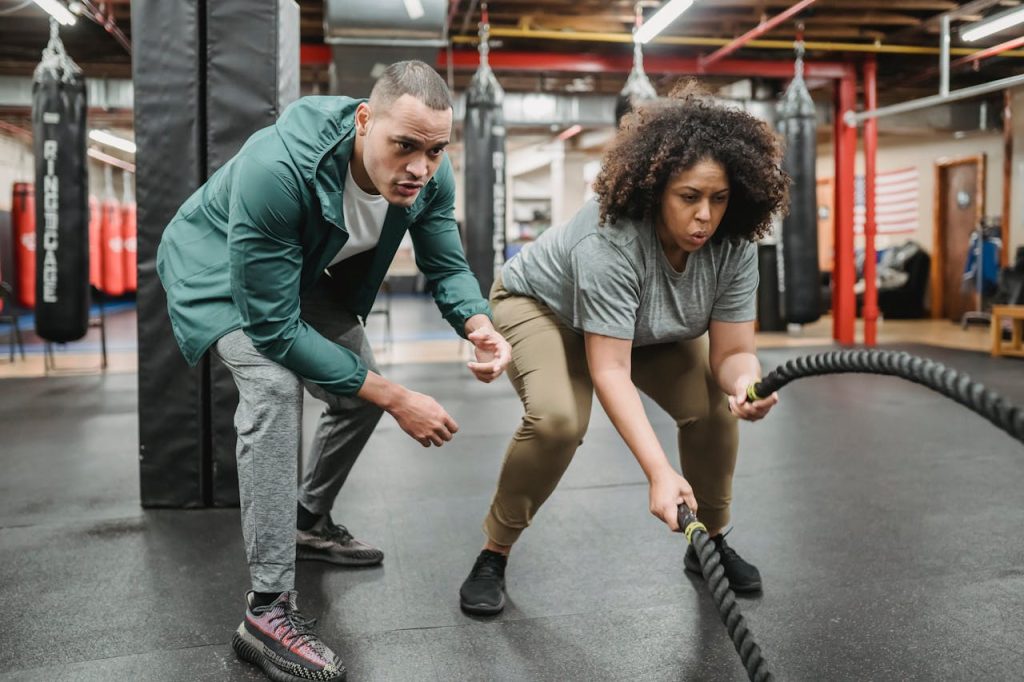Key Takeaways
- Strength training is invaluable for retirees, as it helps counteract age-related muscle loss, supports bone density, and improves balance, ultimately enhancing quality of life. Adding these exercises will help you perform daily activities more easily and stay safe from falls.
- Establish a consistent strength training regimen based on your current fitness abilities. Prioritize correct technique, start with bodyweight movements at first, and add resistance progressively to develop strength in a safe, effective manner.
- Properly manage physical limitations or chronic conditions by working with a team of healthcare professionals. Adapt exercises accordingly, consider assistive devices, and focus on low-impact activities to preserve joint health and enhance enjoyment.
- Aim for a regular training routine, but add variety to the training program to prevent plateaus. Log your workouts and celebrate progress, no matter how small, and change up routines to feel inspired and invested.
- Make strength training part of your everyday life. Consider using household items for resistance or pair exercises with regular activities, like lunging while you talk on the phone. Have fun. Consider inviting friends along to workouts, participating in group fitness classes, or trying out social fitness options.
- Fuel your body, and support your strength training efforts with proper nutrition and hydration. Prioritize consumption of protein-dense meals to help repair and build muscle after strength training. Always drink enough water to perform your best, and avoid any supplements unless recommended by your physician.

Retirement is a phase of life many look forward to—imagining leisurely days spent traveling, enjoying hobbies, and spending quality time with loved ones. But what often catches retirees by surprise is how crucial strength training becomes to fully enjoy those years. It’s not just about fitness—it’s about preserving independence, mobility, and quality of life.
Strength training can improve balance, increase range of motion, boost energy, and even help prevent injury. Yet many retirees find themselves saying the same thing: “I wish I had started sooner.” Whether it’s beginning with basic moves like bodyweight squats or using light resistance bands, getting started doesn’t have to be intimidating—and the benefits are well worth it.
Consistency is key, but the good news is that even two to three short sessions a week can make a noticeable difference. Safe, effective strength training also means focusing on proper form, gradual progression, and allowing time for rest and recovery. Don’t underestimate the power of warm-ups, cooldowns, and incorporating gentle movement like walking or stretching to round out your routine.
If you’re entering retirement—or already well into it—these are the top 10 strength-training tips retirees wish they had known earlier. Starting today can make all the difference.
1. Strength Training Is Essential For Longevity And Independence
Many retirees regret not prioritizing strength training in their younger years because they realize too late how crucial it is for maintaining independence. As we age, muscle mass naturally declines, a process known as sarcopenia, which can lead to frailty and an increased risk of falls.
What They Wish They Knew:
- Strength training isn’t just for athletes or bodybuilders; it’s a necessity for aging gracefully.
- Even simple exercises like bodyweight squats or resistance band workouts can make a huge difference.
- Maintaining muscle strength can prevent the need for assisted living in later years.
Tip: Start small and focus on consistency rather than intensity. A little bit of strength training regularly goes a long way.
2. It’s Never Too Late To Start Strength Training
One of the biggest misconceptions retirees have is that they are too old to start lifting weights. However, research shows that even people in their 80s and 90s can build muscle and improve strength with the right training program.
What They Wish They Knew:
- Strength training benefits everyone, regardless of age.
- The human body is adaptable, and muscles can grow even in later years.
- Starting today is better than never starting at all.
Tip: Find a beginner-friendly program or work with a trainer who specializes in senior fitness.
3. Strength Training Helps Reduce Joint Pain And Arthritis
Many retirees assume that lifting weights will worsen joint pain, but the opposite is true. Strength training helps to strengthen muscles around joints, reducing stress on them and alleviating arthritis symptoms.
What They Wish They Knew:
- Strong muscles provide better support for the joints, leading to less pain.
- Resistance training improves joint flexibility and range of motion.
- The right exercises can reduce inflammation and stiffness.
Tip: If you have arthritis, focus on low-impact strength exercises like resistance bands, water resistance workouts, and controlled bodyweight movements.
4. Balance And Stability Training Is Just As Important As Strength
Falls are a leading cause of injury in older adults, and many retirees wish they had worked on their balance and coordination earlier in life. Strength training, combined with balance exercises, can help prevent falls and keep you steady on your feet.
What They Wish They Knew:
- Strength training should include exercises that improve balance, like single-leg stands or step-ups.
- Core strength plays a crucial role in stability and posture.
- Poor balance can lead to serious injuries, but training can help prevent them.
Tip: Incorporate balance exercises into your routine, such as heel-to-toe walking, standing on one foot, or using a stability ball.
5. Proper Form Is More Important Than Heavy Weights
Many retirees learn the hard way that lifting too heavy or using improper form can lead to injuries. Proper technique ensures that you get the benefits of strength training without putting unnecessary strain on your body.
What They Wish They Knew:
- Lifting lighter weights with proper form is more effective than lifting heavy weights with bad form.
- Strength training is about controlled movements, not just power.
- A trainer or physical therapist can teach the correct technique to prevent injuries.
Tip: If you’re unsure about your form, start with bodyweight exercises or work with a fitness professional before adding resistance.
6. Strength Training Boosts Bone Density And Prevents Osteoporosis
Bone density decreases with age, making older adults more susceptible to fractures. Retirees who started strength training later in life often wish they had known earlier how effective it is at preventing osteoporosis.
What They Wish They Knew:
- Weight-bearing exercises, like squats and lunges, help stimulate bone growth.
- Strength training increases bone density and reduces the risk of fractures.
- Women, in particular, are at a higher risk for osteoporosis, making strength training even more essential.
Tip: Include weight-bearing exercises like squats, step-ups, and resistance training to maintain strong bones.
7. Strength Training Can Improve Heart Health
Many retirees assume that cardio is the only way to improve heart health, but strength training also has cardiovascular benefits. Studies show that lifting weights can lower blood pressure, reduce cholesterol, and improve circulation.
What They Wish They Knew:
- Resistance training improves cardiovascular function and overall heart health.
- Strength training can help manage conditions like hypertension and diabetes.
- A combination of strength and aerobic exercises provides the best heart health benefits.
Tip: Incorporate full-body strength exercises, like deadlifts, push-ups, and resistance band exercises, to support heart health.
8. Recovery And Rest Are Just As Important As The Workouts
Many retirees overdo it when they start strength training, only to experience soreness, fatigue, or even injuries. Recovery is a crucial part of the process.
What They Wish They Knew:
- Strength training breaks down muscle fibers, and rest is necessary for them to grow stronger.
- Overtraining can lead to injuries, exhaustion, and burnout.
- Sleep, hydration, and nutrition play key roles in muscle recovery.
Tip: Schedule at least one or two rest days per week, and listen to your body. If you’re feeling sore, consider gentle stretching or light activity instead of skipping movement entirely.
9. Nutrition Plays A Huge Role In Strength And Muscle Growth
Many retirees regret not paying attention to their diet earlier. Strength training alone isn’t enough—proper nutrition is essential for muscle recovery and energy.
What They Wish They Knew:
- Protein intake is crucial for muscle repair and maintenance.
- Healthy fats, vitamins, and minerals support joint health and muscle function.
- Hydration is key for muscle performance and preventing cramps.
Tip: Focus on lean protein sources (chicken, fish, beans, and eggs), healthy fats (avocados and nuts), and complex carbs (quinoa, sweet potatoes, and whole grains).
10. Strength Training Improves Mental Health And Confidence
One of the most surprising benefits of strength training is the positive impact on mental health. Retirees who commit to regular exercise often experience less stress, better sleep, and improved mood.
What They Wish They Knew:
- Strength training can reduce anxiety, depression, and cognitive decline.
- Lifting weights boosts confidence and a sense of accomplishment.
- The sense of community in fitness classes can help reduce feelings of loneliness.
Tip: Consider joining a senior fitness class or small workout group for motivation and social interaction.

Adapting Exercises For Physical Limitations
Strength training provides profound health benefits for older adults, yet 90% of retirees face physical limitations that often make conventional workout routines difficult or unsafe. By incorporating a strength training program that includes simple exercises and modifications tailored to their needs, seniors can achieve their baseline fitness goals safely and effectively. Here are some strategies and deliberations to inform and help finesse this process.
Modifying Exercises For Joint Pain
Concerns over joint pain are a huge barrier. Low-impact options such as seated leg lifts or water aerobics can help you strengthen your muscles without putting too much strain on them.
Resistance bands allow for controlled tension, making them perfect for reducing joint stress versus using heavier weights. With movement, taking time to incorporate exercises that improve range of motion, like relaxing stretches or yoga poses, promotes flexibility and overall joint health.
It’s important to check in with your joints frequently. If you start feeling discomfort, modify the intensity or exercise to prevent it. If you notice your knee pain aggravating with squatting, consider doing only partial squats. Wall sits are another way to continue to build strength while remaining active enough to avoid aggravating your symptoms.
Using Assistive Devices When Needed
Assistive tools such as stability balls, chairs, or resistance bands introduce extra support and balance to workouts. Chairs are great for seated exercises, and a wall can help support movements such as standing leg lifts.
Designing adaptive equipment specifically for older adults, like ergonomic dumbbells or handgrips, increases accessibility. Common household objects, such as canned foods or water bottles, can be great replacements for dumbbells.
This last tip empowers creativity and flexibility in your training routine.
Working Around Chronic Conditions
Working with health professionals is key. For instance, individuals with arthritis may focus on low-impact exercises, like swimming, to minimize pressure on the joints.
Monitoring symptoms closely ensures that intensity levels align with personal comfort and safety. Strength-building exercises, such as modified push-ups or seated bicep curls, can empower participants to improve health without ignoring unique limitations.
Creating A Sustainable Strength Training Plan
Creating a sustainable strength training program that aligns with your lifestyle takes some planning and dedication, but it’s worth it! A consistent training approach means more lasting benefits—from improved muscle strength to enhanced quality of life and overall health. Here are the essential components to consider.
- Define clear, measurable goals to track progress.
- Break goals into manageable milestones to stay motivated.
- Partner Up: Find a consistent workout partner or join small group classes to increase accountability.
- Incorporate strength training into daily tasks for ease.
Establish Achievable Objectives
Create SMART goals. SMART stands for specific, measurable, attainable, relevant, and time-bound. For instance, work towards adding 5 more pounds to your dumbbell weight in four weeks of training to maintain the progressive overload you need.
By dividing larger goals into smaller, more immediate ones, such as “I will complete three sessions per week,” you’re making each step tangible and less intimidating. Occasionally, revisit your goals as you progress and adapt them to fit your evolving requirements.
Celebrate milestones—even if it’s just lifting heavier weights or mastering a new move—along the way to keep motivation high.
Find An Exercise Buddy
A partner can make all the difference. Whether it’s a sibling or a friend, inviting others to work out encourages accountability and allows you to have fun with training sessions.
Seek out community fitness groups or online fitness forums to find others who are on the same journey as you. Plus, working alongside others helps to foster an environment of encouragement and support.
Integrate Strength Training Into Daily Life
Carry strength training into your daily life by building it into tasks you’re already doing. Challenge yourself by carrying groceries as resistance training, or use a heavy and stable chair to try seated leg lifts.
Even simple activities like standing during phone calls or taking the stairs instead of the elevators can add movement to your day.
The Mental Game Of Strength Training
Strength training requires a great physical demand. The mental side is equally important, particularly for older adults who are new to fitness. If so, then building and maintaining a powerful mindset will make an enormous impact on the experience and results you get.
Here are three key strategies to strengthen the mental game and ensure long-term success.
Cultivate A Positive Mindset
Having a positive mindset is key, and building on that is important. Begin by repeating simple positive statements every day, such as, “I am increasing my strength each day.” This builds confidence and increases motivation.
Talk about how strength training can help regain mobility or maintain independence instead of highlighting issues tied to aging. Having friends or family members who support your new journey will go a long way because motivation and accountability are key to sticking to goals.
When the inevitable setbacks happen, instead of seeing your setback as a failure, see it as an opportunity to learn and adapt. If a workout isn’t presenting a challenge, try upping the ante! Before throwing in the towel, try to learn a thing or two about recovery tactics.
Appreciate Little Wins
Recognizing the efforts being made—even if they’re minimal—creates momentum. Enjoy the small wins, such as lifting a new weight or nailing a difficult exercise. By journaling your accomplishments, you create an easily accessible record of that progress.
Sharing your successes with your friends, a workout partner, or a group will increase your motivation even more. For instance, nailing an important balance exercise at the start of today’s session might set the stage for advancing to more challenging dynamic movements in future workouts.
Each success serves as a building block to bigger things.
Stay Motivated And Committed
The most important element of any fitness regimen is consistency. Use calendar alerts to plan your workout times so they become an established sequence in your day-to-day. Finding your fitness tribe, whether in person or virtually, is a great source of motivation and accountability.
Stay on track. Regularly review your goals to avoid stagnation and a loss of motivation. For instance, introducing fresh exercises such as resistance band routines or small group classes can reenergize things.
When those workouts have a purpose to them and they’re fun, that commitment is going to blossom.
Nutrition And Hydration For Strength
As we enter older adulthood and beyond, maintaining our baseline fitness is especially important for keeping muscle health. After age 30, we begin losing muscle mass at a rate of 3% to 8% per decade, with an even greater decline after age 60. This process, known as sarcopenia, emphasizes the need for a consistent strength training program coupled with good nutrition and hydration to counteract muscle loss and improve overall health.
Fuel Your Muscles With Protein
Protein is another crucial player. A key component in repairing and growing muscle, protein is a non-negotiable nutrient. Plan meals and snacks with foods high in proteins such as chicken, turkey, fish, eggs, and low-fat dairy sources.
Plant-based options, like beans, lentils, tofu, and nuts, work just as well and are more inclusive of varying dietary preferences and restrictions. Get the most out of your protein by aligning your daily intake with how active you are. Aim for at least 0.36 grams per pound of body weight, and increase until you start to see the desired results.
Timing is important as well. Incorporating protein in the few hours post-workout may help maximize muscle repair and development.
Stay Hydrated For Optimal Performance
Hydration has a direct influence on strength and endurance. Learn to make drinking water a regular practice every day, especially before, during, and after you train. During long or vigorous training sessions, plan to include electrolyte-rich options, such as sports drinks, to help replenish the minerals lost through sweat.
Monitor hydration indicators, like the color of your urine, to make sure you’re drinking enough water to fuel your body.
Consider Supplements If Necessary
Although whole foods need to be your main priority, supplements can sometimes make up for what we miss in our diets. Protein powders or creatine can help you reach strength goals, but talk to a healthcare provider before incorporating any supplement.
Stick with established brands and use only the products that meet your nutritional needs.
Combining Strength With Other Activities
As we get older, adopting a well-rounded level of fitness is crucial to allow us to continue to live healthy, independent lives. Strength training is important for managing activities of daily living like bathing, dressing, and cooking. By combining it with other synergistic activities, you can maximize your impact and improve your physical and emotional health.
Here’s some quick advice on how to combine them successfully.
Integrate Cardio For Overall Fitness
Pairing strength training with cardio-focused workouts will help you develop a more well-rounded fitness plan. Aerobic activities like walking, swimming, or cycling reduce the risk of heart disease and increase endurance, both of which help you to remain active.
By scheduling cardio on days you are not doing strength training, you give your muscles recovery time while keeping yourself engaged. For instance, a quick 30-minute walk will increase your heart rate and boost blood flow.
Using a fitness tracker to monitor your heart rate ensures you’re working at a level that benefits your endurance without overexertion.
Incorporate Flexibility And Mobility Work
These kinds of flexibility and mobility exercises ideally supplement strength training, helping to counteract stiffness and improve the available range of motion at joints. Dynamic stretches such as leg swings, walking lunges, and arm circles help get your body primed for movement before a workout.
Later, static stretches allow you to cool down smart and proper. Yoga or Pilates classes can help with general or targeted postural and movement issues, helping to relieve tension and enhance body awareness.
For example, the ever-popular downward dog stretch soothes both your flexibility and core stability. This increased emphasis on mobility not only promotes long-term physical health but decreases the risk of injury.
Listen To Your Body And Adjust Accordingly
Adapting your routine based on energy levels and recovery needs ensures consistent progress. If you experience soreness or fatigue, reduce intensity or substitute with low-impact movements.
Regular self-assessments help you modify exercises to stay safe and effective. Remember, even at 80, exercise remains beneficial, as noted by experts in aging and fitness.

Final Remarks
At Fitness Ellipsis, we believe that strength training will improve how you move, feel, and live—at any age! It’s more than just lifting weights—it’s about gaining confidence, developing better balance, and being able to continue doing what you love over the long term. Each incremental progress is an achievement! Modify your moves for your abilities, and combine your sessions with a healthy diet. The longer you do it, the more you’ll feel the difference in your daily activities.
Absorb these nuggets of knowledge and tailor them to fit your needs. Figure out a manageable starting point and just focus on progressing, however small that may be. What you invest in today directly develops the energy and autonomy you’ll thrive with in your later years.
Until next time, stay curious, stay safe, and have fun out there on your strength-training journey! Above all, remember that you can do this—your future self will be grateful!
Frequently Asked Questions
1. How Often Should Retirees Do Strength Training?
Start with 2–3 days per week of your workout routine, if possible. Incorporate strength exercises and allow for rest days to focus on recovery.
2. What’s The Safest Way For Beginners To Start Strength Training?
Begin with lighter weights or resistance bands as part of your strength training program. Prioritize quality over quantity in your workout routine and always control the movement. Have a personal trainer or physical therapist take a look if you’re not sure.
3. Can Strength Training Help With Joint Pain?
Yes! It builds the muscles around your joints, giving them much better support and protecting them from wear and tear and pain. For those with a history of high-stress activity, starting a new exercise regimen with low-impact exercises can help prevent injuries and support your baseline fitness goals.
4. What If I Have Physical Limitations?
Make adjustments to your workout routine based on your skill set. Consider seated or modified movements as necessary. Consulting with fitness experts or a physical therapist to design your return to activity can provide a safer, more effective strength training program.
5. Do I Need Special Equipment For Strength Training?
Not at all; even bodyweight exercises such as squats or push-ups will do the trick. Incorporating simple exercises like these into your workout routine can help establish a strong baseline fitness.
Start Your Journey To Lifelong Strength And Independence At Fitness Ellipsis!
Ready to make your retirement years more vibrant, active, and enjoyable? At Fitness Ellipsis, we believe building and maintaining muscle is key—not just for looking and feeling your best but for preserving your independence, confidence, and overall quality of life. Our expert team specializes in crafting personalized strength-training programs tailored for retirees, ensuring every workout is both safe and deeply rewarding.
Whether you’re dipping your toes into resistance exercises for the first time or you’re already a fitness fan, our supportive and motivating approach will help you stay driven. From gentle resistance moves and core-building routines to focused muscle-strengthening sessions, each step enhances your power, stability, and freedom to keep doing the things you love—on your terms. So, why wait to reclaim your vigor and self-assurance? Join the Fitness Ellipsis community today, and let us guide you toward a stronger, healthier, and more fulfilling retirement. Reach out to Fitness Ellipsis now to learn more and take your first step toward a future of unstoppable vitality and independence. Your journey to lifelong strength starts right here!




